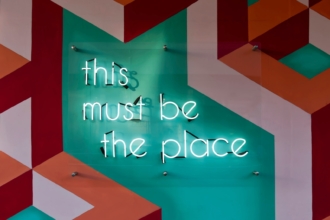This was it.
Amir was ready to embark upon the journey of a lifetime.
After breaking up with his girlfriend, he decided to trade the comfort of a traditional job for the thrill of remote work in Taiwan.
Like many millennials, he felt disillusioned by the prospect of working for someone else in a cubicle until he was 65 years old.
Meta Wagner, Emerson College professor, wrote about this phenomenon in an opinion piece for the Boston Globe:
“When a creative writing student of mine recently acknowledged that being confined to an office cubicle was one of her greatest fears, everyone in class solemnly nodded as if it were a universal truth.”
However, young people are not alone in their dislike of the traditional 9-to-5 — they are just more vocal.
According to a 2017 Gallup poll, a stunning 85 percent of anonymous workers surveyed admit to hating their jobs. The study included participants from nearly 200 countries around the world.
While reasons for job dissatisfaction are multi-faceted, a common source of frustration seems to be lack of autonomy.
And it makes sense:
The majority of employees are told where to go, when to work and how to work for one-third of their adult lives. Another third of their time is devoted to sleep, leaving an average of 8 hours of freetime per workday.
Factor in office commutes, meal prep, exercise, and the miscellaneous responsibilities of being an adult, and the amount of free time per workday shrinks to less than 4 hours.
No wonder a growing number of professionals are enticed by Instagram shots of lifestyle bloggers lounging in hammocks.
Recent innovations like Slack, video conferencing, and cloud-based storage have made working beachside — piña colada in-hand — a reality for an audacious few.
However, talk to enough digital nomads, and you will find remote work isn’t always a solution to job dissatisfaction. And it definitely isn’t always as glamorous as social media influencers make it seem.
Research shows 100 percent remote work isn’t the answer for everyone; even if the practice is becoming increasingly common.
How common is remote work?

Take the US. According to Gallup, 43 percent of Americans spend at least some time working remotely. The organization surveyed more than 15,000 employed adults in a 2016 follow-up survey.
The results indicate that remote work is becoming increasingly common in industries across the board.

Obviously, some jobs lend themselves to remote work more than others. Those most likely to work remotely can be found in the fields of real estate, finance and insurance. Conversely, individuals in healthcare, education and retail are less likely to work remotely.
Even countries that are considered more conservative, like Japan, are experimenting with employee flexibility. As reported by The Wall Street Journal, more than 10 percent of all Japanese workers are expected to work from home one day per week by 2020.
So, who is more engaged: Office dwellers or remote workers? The numbers suggest it’s the nomads who enjoy the best of both worlds.
Employees who spend 60 to 80 percent of their time away from the office report the highest rates of engagement, according to Gallup.
While every organization is unique, and I don’t believe in blanket statements, the finding suggests something important:
Most professionals benefit from a) Having some autonomy over their own schedules and b) Experiencing face-to-face connection with their coworkers on a regular basis.
At Jotform, we love how the digital nomad revolution is taking over the world but we don’t enforce a 100 percent remote work policy for the following reasons:
The downside of remote work
1. It can be lonely
Remember our friend Amir?
After working remotely for a year, he discovered living as a digital nomad wasn’t ideal for his personality:
“I lived in Taiwan for about a year before I returned to Europe,” says Amir Salihefendic, CEO and founder of Doist. “I learned some hard lessons as I went through a cocktail of depression, anxiety, insomnia, and loneliness. It took me a few years to fully recover from that experience.”

Amir realized he needed an everyday routine, a close-knit social circle, and a sense of belonging to keep him grounded.
The entrepreneur insists his story isn’t unique, and the extreme flexibility of remote work sometimes produces the opposite of what one would expect: Unhealthy work-life balance.
Obviously, working remotely doesn’t require moving to a foreign country. Many remote workers enjoy working from their home city, state or country. But even they get lonely sometimes.
Stanford professor Nicholas Bloom conducted a 2-year study of remote workers for China’s largest travel agency. The study tracked two control groups — one team worked remotely 100 percent of the time; the other worked in the office — before revealing a surprising outcome.
Despite the fact that the remote workers were a full-day’s-worth more productive per week than their office-dwelling counterparts, the majority of them chose not to continue working from home every day.
The reason was they felt too isolated. This is consistent with other studies, suggesting remote work coincides with loneliness.
At Jotform, we give our team members the flexibility to customize their work schedules in-house. This provides them with the same autonomy enjoyed by remote workers minus the isolation.
2. Innovation can become stagnant
When it comes to your company, there’s no one-size-fits-all solution.
It doesn’t have to be black or white, either. You don’t have to enforce a 100 percent remote work. The same goes for requiring your staff to work from the office at all times.
While it’s possible to establish a winning company culture with a completely remote team, we figured it isn’t easy.
At Jotform, our employees work in small, cross-functional teams designed to foster relevant discussion. Each team has its own office and is encouraged to make their own decisions as if they were an independent company.
And somehow, most of the best ideas in our 12-year history came from those teams — they have become the engine that grew us to 4.2 million users, bringing 1 million signups last year alone.

Could they just stay home and ping each other on Slack? Yes, but they could also miss out on the serendipity that happens through close proximity; the cross-pollination that starts by simply refilling their coffee at the same time every day.
I don’t think this means remote-only companies aren’t innovative, but observing recent shifts among some of the world’s leading firms have been interesting.
Take Michelle Peluso, IBM chief marketing officer. Last year, Peluso made headlines when she announced on the company intranet that thousands of remote employees would be required to return to the office.
The company said a desire to compete with more agile companies in developing new technologies had motivated the change. Peluso also listed an inspiring location as key to the success of fashion startup Gilt during her run as CEO.
IBM isn’t alone in moving away from remote work; companies like Yahoo, Reddit and Samsung have also called teams back to the office within the last several years.
Retail giant Best Buy even revoked its remote work policy after experiencing enormous benefits. In 2006, the company reported an average 35 percent increase in productivity from departments working wherever they wanted, whenever they wanted.
“It turns out the value of innovation is so strong that it trumps any productivity gain provided by [remote work],” says John Sullivan, professor of management at San Francisco University. “[Remote work] was a great strategy for the 90s and 80s, but not for 2015.”
Interestingly, these leading organizations are all prioritizing the same thing — innovation within an increasingly competitive technological landscape.
With new startups threatening to disrupt the status quo every day, the struggle to stay relevant is fierce.
Even my small company has felt the pressure to continually release new product iterations to stay in the game. I’ll let you in on a secret: When Google launched their Forms app, a service similar to what Jotform provides, I first felt like I had been punched in the stomach.
One of the biggest tech companies in the world was encroaching upon our territory. And all I could think was: How can we do it better?
I knew the answer resided in the team of 130 employees we had built over the past several years. Beyond their individual talents, each person was hired because they a) Shared the company vision and b) Enjoyed collaborating with others and making cool things.
Were we separated by computer screens in various time zones, we wouldn’t have generated half of the ideas that resulted in huge wins.
Obviously, innovation isn’t an essential job criterion for every employee. However, creative stagnation worsened by distance is a significant hurdle for employers that cannot be ignored.
3. Employees risk becoming expendable
Another downside to working remotely is the potential perception that remote team members aren’t really part of the team.
According to a global study of more than 25,000 employees, 62 percent of remote workers fear their onsite coworkers don’t think they are working as hard enough.
Additional research echoes this sentiment, suggesting remote workers are more likely to worry coworkers are talking behind their backs, changing projects without telling them and not respecting their professional priorities.
Personally, I question how many of these assumptions are based in reality. However, Dan Schawbel, partner and research director at Future Workplace, seems to have experienced something else:
“When I first started working from home back in 2010, my peers thought I was watching TV, playing video games and sleeping instead of doing work,” he says. “People who have never worked from home or are easily distracted have an image in their head that we are lazy, socially awkward, and unhappy.”

Ironically, most studies show remote workers to be significantly more productive than their peers. But there may be something to the old adage: Out of sight, out of mind.
“The minute you are not part of the team dynamic, the hi-fives, the bigger than me mentality, the small things you see people do for one another, the easier it is to just be a “worker” to your co-workers,” says Wil Reynolds, founder & director of strategy at Seer Interactive.
No one wants to treat remote team members unfairly. But, without the visual reminder of someone at their desk, it’s easy to minimize their contributions.
Additionally, professional relationships are less likely to transcend into the kind of friendships that build company loyalty.
This is a clear disadvantage to both employers wanting to reduce attrition and remote workers wanting to feel “part of the team.”
Remote work might not be the answer
A MacBook Pro, coffee mug, and Balinese beach on the background make a beautiful Instagram photo for sure. But full-time remote work can also be what many people think they want until they get it.
We need to talk more about the reality of stronger communication barriers, increased isolation and decreased creative opportunities — the unexpected cost of 100% remote work.
Are there individuals who thrive working remotely 100 percent of the time? Absolutely. However, I suspect these individuals are the exception — not the rule.
Companies can strive to create the kind of office environment that makes employees want to come to work every day. And that requires creating a company culture consisting of individuals who thrive on collaborative innovation, too.
At Jotform, our best ideas often come from unplanned encounters in hallways, meetings and lunch hours. These informal conversations happen outside of “working moments” because our team members genuinely enjoy interacting with one another.
As previously mentioned, an astonishing 85 percent of people report feeling dissatisfied with their jobs. My suspicion is that remote work isn’t necessarily the missing ingredient for the majority of these individuals.
It’s also the community. It’s collaboration. And it’s creativity.












































































































Send Comment:
1 Comments:
More than a year ago
Jotform is the Easiest Online Form Builder. Founded in 2006, Jotform was the first WYSIWYG form builder, and we’ve never stopped innovating since. Driven by making our users’ lives easier, we’re continually improving upon what works, and building new features and integrations to make Jotform work even better. Our over 100 integrations with partners including PayPal, DropBox, and Salesforce can help your forms be more powerful. Our Form Designer, the most advanced in the industry, can help you make your form gorgeous and just the way that you imagine. The Form Analytics feature helps you keep an eye on how your forms are performing filehipoo
One of the best sites in recent times that we have come across.